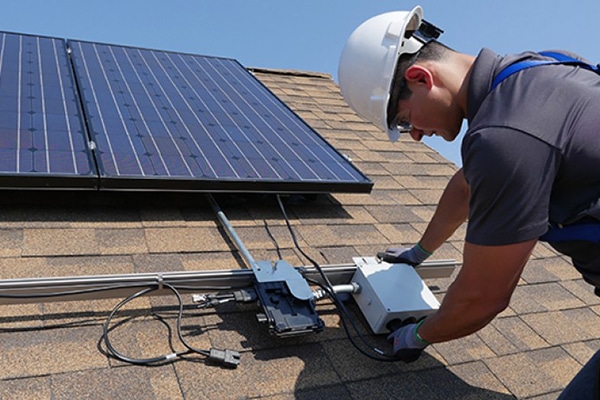Image source: Bright Earth Solar
Harnessing the full potential of solar panels requires more than just sunlight; inverters are indispensable components of every solar panel system. Picture this: while solar panels capture energy from sunlight, inverters channel that energy to produce electricity compatible with your home.
In essence, inverters perform the crucial task of converting the direct current energy (DC) generated by solar panels into alternating current (AC) electricity usable by household appliances. These unsung heroes of solar panel systems vary in size and shape but significantly contribute to overall system efficiency.
Traditional string inverters consolidate multiple panels into a single unit for conversion, whereas microinverters operate at the individual panel level. They optimize the conversion process, enhancing the efficiency of your solar panel system. Let’s delve deeper into microinverters, their technology, and how they compare to other types of inverters.
Microinverters Explained: Function and Benefits

Microinverters play a crucial role in converting solar panel electricity into usable power. Unlike centralized string inverters, which typically handle entire solar panel systems, microinverters are situated at individual solar panel sites. While most systems with microinverters feature one per panel, it’s common for a single microinverter to connect to several panels.
Classified as module-level power electronics (MLPE), each microinverter operates independently at the panel level, unlike traditional string inverter technology. This individual operation proves advantageous for complex installations or those affected by shading. Unlike centralized string inverters, microinverters ensure each panel operates efficiently, even if one panel underperforms.
Pros and Cons of Microinverters
Microinverters offer flexible solutions for many solar installations, yet they may not suit everyone’s needs.
Pros
- Ideal for complex or shaded roofs, operating at the panel level without requiring power optimizers.
- If one microinverter malfunctions, only the attached panel shuts down, facilitating quicker diagnosis and repair compared to central string inverters.
- Microinverters accommodate system expansion over time, allowing additional panels without matching inverter power output.
Cons
- Generally pricier than string inverters, necessitating careful consideration of long-term performance versus upfront costs.
- Maintenance can be challenging and costly, given their rooftop location, especially if labor isn’t covered by warranty.
- Clipping, a phenomenon where microinverters may limit panel output, requires attention during system selection to optimize performance.
When to Opt for Microinverters
Microinverters prove advantageous when your roof exhibits multiple planes facing various directions or experiences shading throughout the day. Their suitability extends to roofs with different angles, enhancing performance by addressing individual panel production issues.
Conversely, if your roof features a single south-facing plane without shade, it’s advisable to consult an installer for alternative options. In such scenarios, the added expense of microinverters may not justify their benefits.
Key points
- Microinverters, a form of solar inverter technology, are individually installed at each panel site.
2. They provide various advantages, including rapid shutdown features, adaptable panel layouts, and precise panel-level monitoring and diagnostics.
3. Microinverters generally incur higher costs compared to conventional string inverters.
Comparing Microinverters to Other Solar Inverter Types
Among the three common inverter options – microinverters, string inverters, and power optimizers – let’s explore how microinverters differ:
String Inverters vs. Microinverters

The primary distinction lies in the wiring approach. String inverters typically require only one or two units to wire multiple panels, while microinverters connect individually to each panel.
String inverters are generally more cost-effective in terms of installation and maintenance due to their simpler wiring. However, this simplicity can make system expansion more costly and can also result in decreased efficiency if one panel underperforms, affecting the entire circuit.
Power Optimizers vs. Microinverters
Power optimizers, unlike microinverters and string inverters, do not directly convert DC to AC electricity. Instead, they condition the DC electricity and transmit it to a central inverter. These module-level power electronics (MLPEs) share similarities with microinverters, enabling individual panel performance monitoring and providing flexibility in system construction.
How to Assess Microinverters
When evaluating your microinverter options, consider several key factors

Efficiency
Microinverters vary in efficiency, measuring energy losses during DC to AC conversion. Higher efficiency microinverters maximize solar electricity production, although actual performance can be influenced by climate and weather conditions. Look for weighted efficiency ratings, such as the California Energy Commission (CEC) rating, to align expectations with real-world conditions.
Size
Microinverters are available in various sizes to match panel voltage levels. Opt for a microinverter that suits the panel’s energy output to minimize clipping. You may encounter single-phase and three-phase microinverters, each offering a different power distribution. While single-phase microinverters are cost-effective for most home systems, three-phase options cater to larger properties with higher energy demands.
Configuration
Microinverters can accommodate individual panels or multiple panels, such as two-in-one or four-in-one configurations. Consolidating panels with fewer microinverters can reduce costs.
Warranty
Most microinverters feature a 25-year warranty, safeguarding against manufacturing defects or degradation. Compare warranty agreements to ensure adequate coverage and peace of mind.
Price
While microinverters aren’t typically the priciest component, consider the cost relative to efficiency and warranty. Higher-priced microinverters with superior efficiency and longer warranties may offer better value depending on system requirements.
Rapid Shutdown Compliance
Ensure microinverters comply with rapid shutdown requirements for safety. Built-in software enables automatic shutdown during emergencies, eliminating the need for additional hardware.
Monitoring
Look for microinverters equipped with smart monitoring systems for real-time performance updates. Monitoring options vary, with some offering mobile apps for convenient access to system data.





